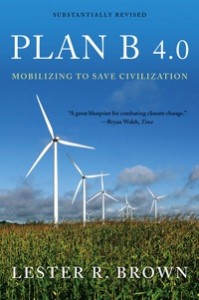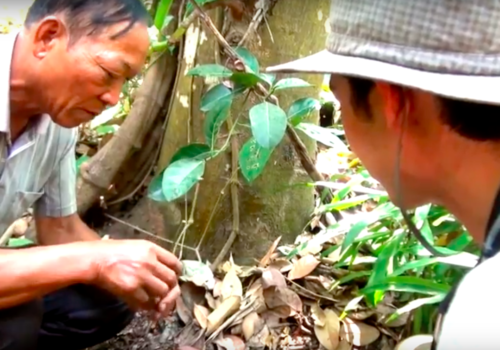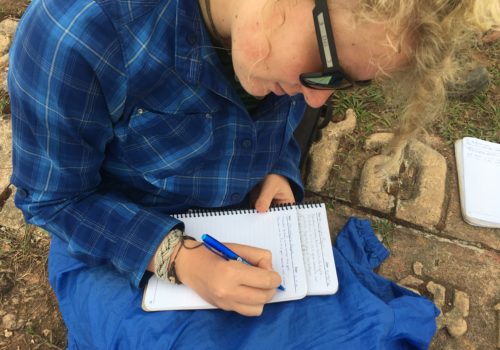 Great new book out from Lester Brown, Plan B 4.0: Mobilizing to Save Civilization. The book is both a call to action and a hopeful message showing what is already being done. Wind power, for example, is coming online faster than expected, and huge gains are being made in de-carbonizing our civilization. However,
Great new book out from Lester Brown, Plan B 4.0: Mobilizing to Save Civilization. The book is both a call to action and a hopeful message showing what is already being done. Wind power, for example, is coming online faster than expected, and huge gains are being made in de-carbonizing our civilization. However,
The question we face is not what we need to do, because that seems rather clear to those who are analyzing the global situation. The challenge is how to do it in the time available. Unfortunately we don’t know how much time remains. Nature is the timekeeper but we cannot see the clock.
Brown clearly lays out that the multiple issues facing us (climate change, energy, etc.) eventually lead to the problem of food. How do we balance food demand and supplies? From the start of the book:
From time to time I go back and read about earlier civilizations that declined and collapsed, trying to understand the reasons for their demise. More often than not shrinking food supplies were responsible. For the Sumerians, rising salt levels in the soil—the result of a flaw in their irrigation system—brought down wheat and barley yields and eventually the civilization itself.
For the Mayans, soil erosion exacerbated by a series of intense droughts apparently undermined their food supply and their civilization. For other early civilizations that collapsed, it was often soil erosion and the resulting shrinkage in harvests that led to their decline.
Does our civilization face a similar fate? Until recently it did not seem possible. I resisted the idea that food shortages could also bring down our early twenty-first century global civilization. But our continuing failure to reverse the environmental trends that are undermining the world food economy forces me to conclude that if we continue with business as usual such a collapse is not only possible but likely.
This is an important point usually lost in the Global North, where over feeding (obesity) rather then food shortages are currently of concern.
Climate change, of course, is the biggest contextual threat to food supplies. As glaciers retreat the buffer they supply by slowly releasing water in the dry season will disappear. Drying (as we’ve seen in Australia already) is leading to permanent drought, dust storms, and desertification. Sea levels increasing even a small amount lead to salt intrusion. More severe storms, like Cyclone Nargis, devastate standing crops, and their storm surge leads to even more salt being dumped into soils. Shifting rainfall patterns destroy the predictability of rain-fed agriculture. The “shift to the poles” of growing zones challenge farmers with crop yields and new weeds and pests. Demand for bio-fuels pull land out of food production into feeding cars.
Brown lays out the issues of shifting to renewable (non-carbon) based energy, sustainable cities, poverty and overpopulation, restoration ecology and related issues. This last chapter, “Can We Mobilize Fast Enough?” he lays out our options and chances of making it.
There is much that we do not know about the future. But one thing we do know is that business as usual will not continue for much longer. Massive change is inevitable. “The death of our civilization is no longer a theory or an academic possibility; it is the road we’re on,” says Peter Goldmark, former Rockefeller Foundation president and current director of the climate program at the Environmental Defense Fund (EDF). Can we find another road before time runs out?
The notion that our civilization is approaching its demise is not an easy concept to grasp or accept. It is difficult to imagine something we have not previously experienced. We hardly have the vocabulary, much less the experience, to discuss this prospect. We know which economic indicators to watch for signs of an economic recession, such as declining industrial output, rising unemployment, or falling consumer confidence, but we do not follow a similar set of indicators that signal civilizational collapse.
He ends with a challenge:
The choice is ours—yours and mine. We can stay with business as usual and preside over an economy that continues to destroy its natural support systems until it destroys itself, or we can adopt Plan B and be the generation that changes direction, moving the world onto a path of sustained progress. The choice will be made by our generation, but it will affect life on earth for all generations to come.
Get the book (online or hardcopy), read it, and pass it on.
(Download or purchase Plan B 4.0: Mobilizing to Save Civilization. The data the book is based on is going online, as well as other supporting information and resources.)



